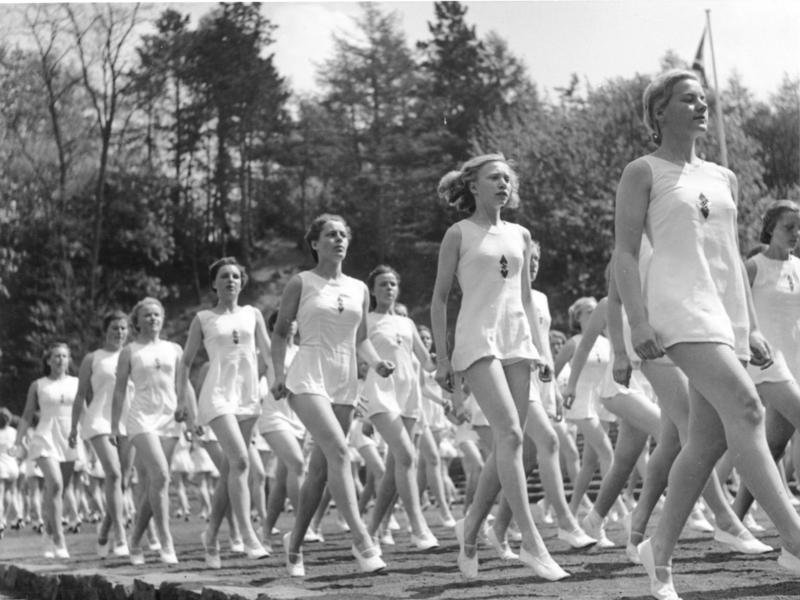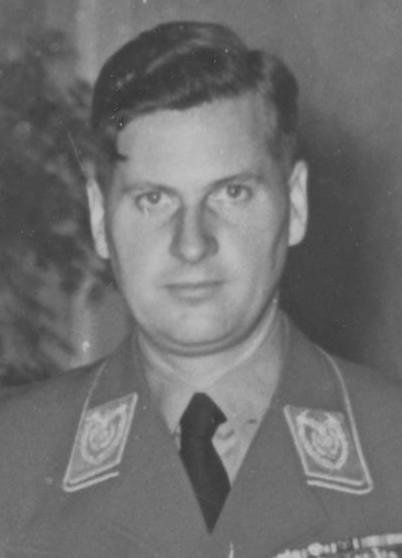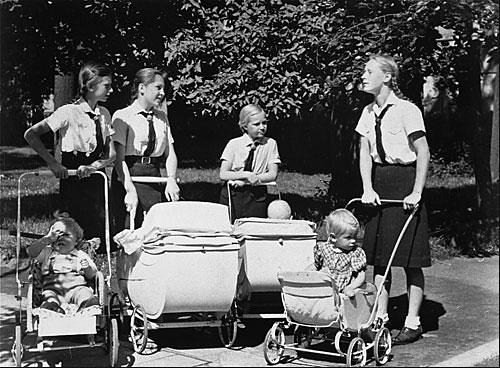
The Band of German maidens (BDM) or
League of German Girls
The League of German Girls or the Band of German Maidens (German: Bund Deutscher Mädel, abbreviated as BDM) was the girls' wing of the Nazi Party youth movement, the Hitler Youth. It was the only legal female youth organization in Nazi Germany.
At first, the League consisted of two sections: the Jungmädelbund ("Young Girls' League") for girls aged 10 to 14, and the League proper for girls aged 14 to 18. In 1938, a third section was introduced, the BDM-Werk Glaube und Schönheit ("Faith and Beauty Society"), which was voluntary and open to girls between the ages of 17 and 21.
Due to the compulsory membership of all young women, except for those excluded for racial reasons, the League became the largest female youth organization at the time with over 4.5 million members.
History
The Bund Deutscher Mädel had its roots in the early 1920s, known as Schwesternschaften der Hitler-Jugend (Sisterhood of the Hitler Youth). In 1930, the BDM was founded, and in 1931 it became the female branch of the Hitler Youth. In the final electioneering campaigns of 1932, Hitler inaugurated it with a mass meeting featuring the League; on election eve, the League and Hitler Youth staged an "evening of entertainment." It did not attract a mass following until the Nazis came to power in January 1933.
Soon after taking office as Reichsjugendführer (youth leader) on 17 June 1933, Baldur von Schirach issued regulations that suspended or forbade existing youth organizations ('concurrence'). Female youth groups were compulsorily integrated into the BDM, which was declared to be the only legally permitted organization for girls in Germany.
Leaders
The Gesetz über die Hitlerjugend (law concerning the Hitler Youth) dated 1 December 1936, forced all eligible juveniles to be a member of HJ or BDM. They had to be ethnic Germans, German citizens, and free of hereditary diseases. Girls had to be 10 years of age to enter this League.
The BDM was run directly by Schirach until 1934, when Trude Mohr, a former postal worker, was appointed to the position of BDM-Reichsreferentin, or National Speaker of the BDM, reporting directly to Schirach. After Mohr married in 1937, she was required to resign her position (the BDM required members to be unmarried and without children in order to remain in leadership positions), and was succeeded by Dr. Jutta Rüdiger, a doctor of psychology from Düsseldorf, who was a more assertive leader than Mohr but nevertheless a close ally of Schirach, and also of his successor from 1940 as HJ leader, Artur Axmann. Rüdiger led the BDM until its dissolution in 1945.
Schirach overall in charge of the HJ & BDM until 1940
Trude Mhor managed the BDM until her marriage on 1937
Rüdiger led the BDM until its dissolution in 1945
HJ leader Artur Axmann after 1940.
“Our people need a generation of girls which is healthy in body and mind, sure and decisive, proudly and confidently going forward, one which assumes its place in everyday life with poise and discernment, one free of sentimental and rapturous emotions, and which, for precisely this reason, in sharply defined feminity, would be the comrade of a man, because she does not regard him as some sort of idol but rather as a companion! Such girls will then, by necessity, carry the values of National Socialism into the next generation as the mental bulwark of our people”.
Trude Mhor 1934
Uniform
The BDM uniform was a full blue skirt, middy blouse and very heavy marching shoes. In 1939, a new uniform was introduced for regional and national leaders within the League of German Girls, and along with the new uniforms came new rank insignia for leaders. These new rank insignia took the form of a silver, and for higher ranks, gold bullion embroidered open-winged eagle on a black (white, on the summer tunic) shield with various types of borders to indicate grade. They were worn on the left chest of the tunic.
Traditions-Arm-Dreiecken, regional sleeve badges, gold is Hitler Youth, silver is Bund Deutscher Mädel
Organisation
As in the HJ, separate sections of the BDM existed, according to the age of participants. Girls between the ages of 10 and 14 were members of the Young Girl's League (Jungmädelbund, JM), and girls between the ages of 14 and 18 were members of the Bund Deutscher Mädel (BDM) proper. In 1938, a third section was added, known as Faith and Beauty (Glaube und Schönheit), which was voluntary and open to girls between 17 and 21 and was intended to groom them for marriage, domestic life, and future career goals. Ideally, girls were to be married and have children once they were of age, but importance was also placed on job training and education.
At the beginning of World War II, the Reichsarbeitsdienst (National Labour Service; RAD) became compulsory also for young women. It lasted half a year. Many young women became Blitzmädel (Wehrmachthelferin or female armed forces helpers) during World War II.
While these ages are general guidelines, there were some exceptions for members holding higher (salaried) leadership positions, starting at the organizational level of "Untergau". As regards lower (honorary) positions, even members of the JM could apply for them after two years of membership and would then obtain such a position typically at the age of 13. The higher leadership was recruited from members over 18 and was expected to maintain salaried office for no more than 10 years, and to leave the BDM by the age of 30. As a general rule, members had to leave when they were married and especially when they had children.
Training and activities
The BDM used campfire romanticism, summer camps, folklorism, tradition, and sports to indoctrinate girls within the Nazi belief system, and to train them for their roles in German society: wife, mother, and homemaker. Their home evenings revolved around domestic training, but Saturdays involved strenuous outdoor exercise and physical training. The purpose of these activities was to promote good health, which would enable them to serve their people and their country. The "home evenings"—ideally to be conducted in specially built homes—also included world view training, with instruction in history. This instruction would include learning the Horst Wessel song, the Nazi holidays, stories about Hitler Youth martyrs, and facts about their locality and German culture and history. Physical education included track and field sports like running and the long jump, gymnastics (e.g. somersaulting and tightrope walking), route-marching, and swimming. The importance of self-sacrifice for Germany was heavily emphasized; a Jewish woman, reflecting on her longing to join the League of German Girls, concluded that it had been the admonishment for self-sacrifice that had drawn her most. Members were also taught the Nazi Party's racial ideas. The League was particularly regarded as instructing girls to avoid Rassenschande or racial defilement, which was treated with particular importance for young females.
Holiday trips offered by HJ and BDM – for example, skiing in winter and tent camps in summer – were affordable; children from poor families got subsidies. These offers were popular.
The League encouraged rebellion against parents. Der Giftpilz presented the propaganda of a German girl being ordered to visit a Jewish doctor by her mother; the girl protested on the grounds of what she had learned at BDM meetings, and while at the office, remembered the warnings in time to escape being molested by the doctor. She then insisted that her mother admit that the BDM had clearly been in the right.
The preparation camps for the 'Landdienst' (land service) of girls and boys often lay adjacent to each other. 900 of the girls participating in the 1936 Reichsparteitag in Nürnberg became pregnant. In 1937, a prohibition came out saying that camping was forbidden to the BDM.
The Jungmädel were only taught, while the BDM was involved in community service, political activities and other activities considered useful at that time.
Before entering any occupation or advanced studies, the girls, like the boys in Hitler Youth, had to complete a year of land service ("Landfrauenjahr"). Although working on a farm was not the only approved form of service, it was a common one; the aim was to bring young people back from the cities, in the hope that they would then stay "on the land" in service of Nazi blood and soil beliefs. Another form of service was as a domestic work in a family with many children.
The 'Faith and Beauty' organizations offered groups where girls could receive further education and training in fields that interested them. Some of the works groups that were available were arts and sculpture, clothing design and sewing, general home economics, and music.
The BDM on land service duty
Members of the BDM - The league of German girls
Hitler Youth were encouraged to have illegitimate Aaryan children
World War II
The outbreak of World War II altered the role of the BDM, though not as radically as it did the role of the boys in the HJ, who were to be fed into the German Wehrmacht (armed forces) when they turned 18. The BDM were told by their leaders during the invasion of Poland that the Poles were a people "worthy of disgust, genuine sub-humans, who deserved to be ruled by a master race." The BDM helped the war effort in many ways. Younger girls collected donations of money, as well as goods such as clothing or old newspapers for the Winter Relief and other Nazi charitable organizations. Many groups, particularly BDM choirs and musical groups, visited wounded soldiers at hospitals or sent care packages to the front.[citation needed] Girls knitted socks, grew gardens, and engaged in similar tasks. In 1943, Das deutsche Mädel urged on the ten-year-olds just joining the Jungmädelbund that
"It is as if the Führer had spoken to you ten-year-old girls as well, who are now joining the community. From this day on, your small strength, too, will contribute to winning the war and building a greater and more beautiful Reich."
The older girls volunteered as nurses' aides at hospitals, or to help at train stations where wounded soldiers or refugees needed aid. After 1943, as Allied air attacks on German cities increased, many BDM girls went into paramilitary and military services (Wehrmachtshelferin), where they served as Flak Helpers, signals auxiliaries, searchlight operators, and office staff. Unlike male HJs, BDM girls took little part in the actual fighting or operation of weaponry, although some Flak Helferinnen operated anti-aircraft guns.
Many older girls, with Hitler Youth were sent to Poland as part of the Germanisation efforts. These girls, along with Hitler Youth, were first to oversee the eviction of Poles to make room for new settlers and ensure they did not take much from their homes, as furniture and the like were to be left there for the settlers. Their task were then to educate ethnic Germans, either living in Poland or resettled there from the Baltic states, according to German ways. This included instruction in the German language, as many spoke only Polish or Russian. They also had to organize the younger ones into the League. Because many Hitler Youth leaders were drafted into the military, the task of organizing the boys into Hitler Youth also fell heavily on the League. They were also to provide help on the farm and in the household. As the only contact with German authorities, they were often requested to help with the occupation authorities, and they put on various entertainments such as songfests to encourage the down-spirited new settlers. Some members were sent to the colony of Hegewald ( Hegewald was a short-lived German colony during World War II, in Ukraine. It was repopulated in late 1942 and early 1943 by Volksdeutsche settlers transferred from occupied territories of Poland, Croatia, Bessarabia, and the Soviet Union to an area earmarked for the projected Germanization of the Ukrainian lands) for such efforts even when they had to receive gas masks and soldier escorts.
Conversely, the young Polish girls who were selected for "racially valuable traits" and sent to Germany for Germanization were made to join the League as part of the Germanization.
In the last days of the war, some BDM girls, just like some boys of the male Hitler Youth (although not nearly as many), joined with the Volkssturm (the last-ditch defense) in Berlin and other cities in fighting the invading Allied armies, especially the Soviets. Officially, this was not sanctioned by the BDM's leadership, which opposed an armed use of its girls, even though some BDM leaders had received training in the use of hand-held weapons (about 200 leaders went on a shooting course which was to be used for self-defense purposes). After the war, Dr. Jutta Rüdiger denied that she had approved BDM girls using weapons in her interview with Junge Freiheit:
“At the end of the war, Martin Bormann wanted to set up a women's battalion. I replied that I wasn't thinking about it. Women are not suitable to fight with guns in hand. At the very end I (however) only allowed the girls to be trained in pistol shooting so that they could defend themselves in dire need – or even shoot themselves”.
Some BDM girls were recruited into the Werwolf groups which were intended to wage guerrilla war in Allied-occupied areas.
The League of German girls with Children.
BDM recruitment posters
"Hille had to join the Hitler Youth and wear the brown uniform with the Swastika on the armband. We both felt uncomfortable and embarrassed about it. It was never talked about"
Anne Kind OBE
Holocaust Survivor; Quote from Survival.
"…the teacher spoke very seriously to the girls… “At home I want you to keep your eyes and ears open and listen carefully to what your parents, their friends and your brothers and sisters are saying. If you hear them saying anything nasty or critical about our new system, you are to report it to me."
Dorothy Fleming
Holocaust Survivor; quote from Survival.
"Gradually the Aryan girls were joining their equivalent of the Hitler Youth – the Bund Deutscher Mädchen (League of German Girls) – and appeared in school in their new uniforms of navy blue skirts, white blouses, dark ties and white knee-length socks."
Dorothy Fleming
Holocaust Survivor; quote from Survival.
Nazi Germany - Tomorrow's Wives and Warriors - Youth in Hitler's Germany















